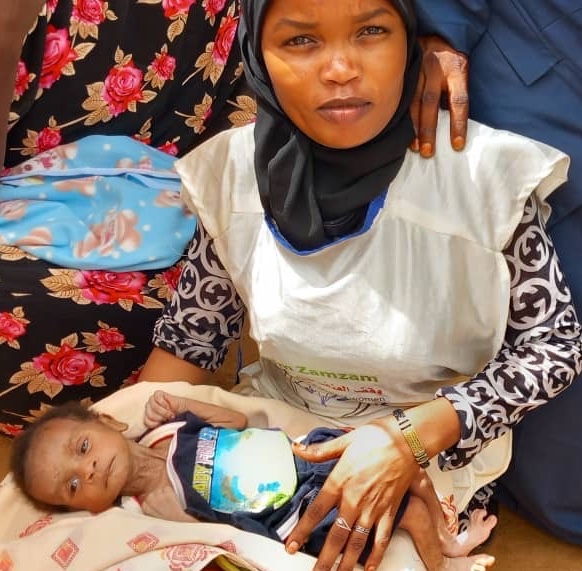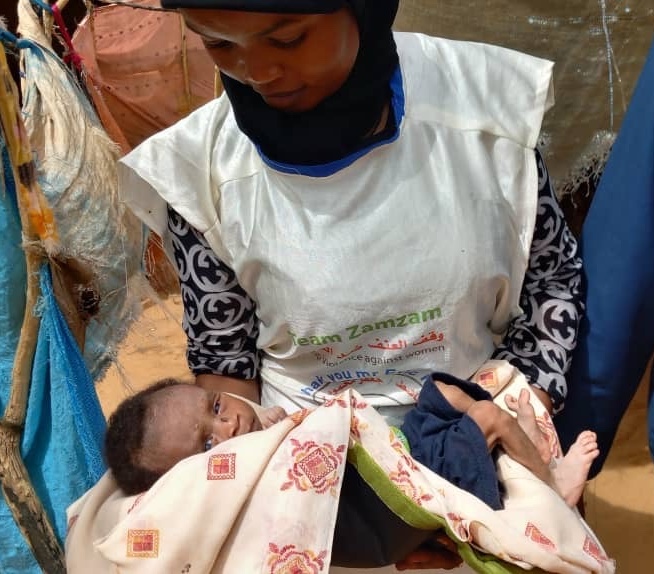Our “Rwanda Moment”—Famine Threatens Millions in Darfur
by Eric Reeves
Thirty years after the horrific spasm of genocidal violence in Rwanda, which claimed the lives of some 800,000 Tutsis and “moderate” Hutus, the international community faces another, even greater threat of human destruction, motivated again in large part by ethnic hatred. Sudan’s Darfur region faces genocide, if one significantly different in means and ambition from the ethnically-targeted violence that garnered so much attention in the 2000s.
On July 31, the authoritative Integrated Food Security Phase Classification (IPC), declared that famine had taken hold in Zamzam camp for internally displaced persons in North Darfur. The IPC uses the following definition of famine: “the absolute inaccessibility of food to an entire population or sub-group of a population, potentially causing death in the short term”). Highly informed predictions suggest that this is only the beginning, and that more than 1 million people in Darfur may starve to death by this fall—and as many as 2.5 million in Sudan as a whole. It is a famine that is being used as a weapon of war, primarily targeting the non-Arab/African populations in Darfur.
This catastrophe has been developing for decades: the 30-year tyranny of former President Omar al-Bashir saw consistently gross underfunding of the agricultural sector in Sudan—a country that could be the breadbasket for northern Africa. This led to the need to import food, despite the country’s immense tracts of arable land.
But the downfall of al-Bashir in 2019 has not produced any real change; rather, it brought to power two military strongmen who have ruthlessly undermined civilian governance, an effort culminating in an October 2021 military coup. Now these two men are locked in an unfathomably destructive war against one another. One is Hamdan Dagalo (Hemedti), leader of the paramilitary Rapid Support Forces (RSF), successor to the infamous Janjaweed; the other is the head of Sudan’s regular armed forces, General Abdel Fattah al-Burhan. Both have had command responsibility for massive war crimes and crimes against humanity, although it is Hemedti who has done most to bring the Darfur region to the point where the IPC declared famine has begun.
A measure of the genocidal intent of Hemedti’s RSF—a ruthless Arab militia of undisciplined mercenaries from Darfur and various countries in the region—is the slaughter of the African Masalit population in and around El Geneina, capital of West Darfur. Beginning in June 2023, the RSF systematically targeted the large Masalit population, especially men and boys, who were brutally murdered. Those who could, mainly women and children, fled across the border to eastern Chad. Many were raped by the RSF as they escaped.
But at least some of the Masalit were able to escape, even if into a humanitarian nightmare around the Chadian city of Adré. The same is not true for those in and around the capital of North Darfur, El Fasher. Having taken control of four of the five state capitals of Darfur, the RSF are intent on completing their control of the region with its assault on El Fasher. But resistance has been stiff, by former Darfur rebel groups and by the SAF, which has a large contingent of another non-Arab tribal group, the Zaghawa. Given this resistance, the RSF has been forced to engage in stand-off artillery shelling, targeting medical facilities in particular.
The location that prompted a declaration of famine is Zamzam camp—some 500,000 internally displaced persons, 15 kilometers to the southwest of El Fasher. Virtually all of them are from Darfur’s many non-Arab/African tribal groups. Painfully, I know from frequent, detailed communications from the small project I and a Darfuri colleague run in this camp just how terribly hungry people are. Hundreds of photographs and videos from Zamzam, coming by way of the team of twenty women who make up our “Team Zamzam,” are ghastly beyond description. There is no food from former markets in El Fasher, and the RSF deliberately make humanitarian access impossible. What food there is comes from profiteers bringing food to Zamzam—at considerable risk. But this is not nearly enough, and obscene inflation in prices puts food out of reach for nearly all in this immense camp.
The Sudan Armed Forces (SAF)—relocated as a “government” from Khartoum to Port Sudan on the Red Sea—also bear large responsibility for the lack of humanitarian access and failure to provide assistance to those desperately in need. Since February 2024 the SAF has denied international organizations access to Darfur through Adré on Chad’s eastern border with Darfur. Adré, particularly during the current peak months of the rainy season, is by far the most important point of access because of its connection to paved roads. But even if the humanitarian convoys at the ready are allowed to enter Darfur from Chad, distribution across much of the region will be impossible because of seasonally flooded rivers and streams (wadis) and washed-out dirt roads.
The SAF regime, six months after closing the Adré crossing, has finally allowed the first few trucks into Darfur carrying critically needed food and medicine. This has been an unconscionable delay that comes only after an authoritative declaration of famine. And since the “Port Sudan regime” denies that famine exists (this without any data-gathering ability in Darfur), there is no assurance that impediments of various sorts will not emerge. Reuters reports today (August 22, 2024) that:
“After 15 trucks had moved through the crossing, out of a total of 131 at the border, the Sudanese government ‘instructed no more movements until procedures received yesterday are agreed,’ Justin Brady, head for the UN’s Office for the Coordination of Humanitarian Affairs in Sudan, said on X late on Wednesday.”
We may expect more bureaucratic and contrived obstacles to full use of Adré for the promised three months. And even once in Darfur, there are no credible assurances that the RSF will allow safe passage, free from extortion checkpoints and hijackings. This brutal paramilitary force is distinguished by extremely poor command and control—and a total ignorance of international human rights and humanitarian law. They are largely untrained (but well-armed) Arab mercenaries from Darfur, Chad, Niger, Central African Republic, and other African countries.
Disgracefully, their brutal campaign for power and wealth in Sudan is being underwritten chiefly by the United Arab Emirates, which the international community refuses to call out in consequential ways for its complicity in human destruction that in Darfur is genocidal. There is certainly no evidence in a White House press release that President Biden spoke forcefully about the UAE role in his mid-June conversation with the ruthless President Sheikh Mohammed bin Zayed. European, Arab, and African countries have been for the most part equally, and expediently, accommodating of UAE ambitions in Sudan.
But the realities of famine in Darfur—and increasingly elsewhere in Sudan—are remorseless, and the predictions of many hundreds of thousands of people starving to death daily come closer to being realized. Unless a feckless international community finds ways to provide security for humanitarian convoys to all of Darfur, the heart-wrenching stories and photographs I receive from Zamzam will continue to come. The dying will continue. And as with Rwanda in 1994, we will be forced to look back on this terrible period and ask—again: “never again?”
Eric Reeves has written extensively on Sudan—and Darfur in particular—for the past twenty-five years. He is presently a Fellow at the Rift Valley Institute (Kenya) and a Trustee of the Darfur Bar Association. He has also been a Senior Fellow at the François-Xavier Bagnoud Center for Health and Human Rights, Harvard University.



